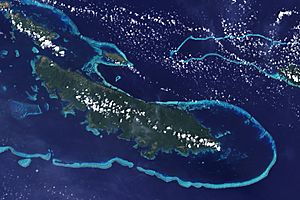Reef facts for kids
A reef is like a natural underwater wall or ridge made of rock, sand, coral, or other materials. It lies just below the surface of the water.
Some reefs form naturally from non-living things, like sand piling up or waves shaping rocks. But the most famous reefs are coral reefs. These are built by living things, mainly tiny animals called corals and a type of algae called coralline algae.
People also create artificial reefs. These can be old shipwrecks or other structures placed on the seafloor. They help create new homes for different kinds of sea creatures, like fish and algae, especially in areas that are otherwise flat and sandy.
The biggest reef system on Earth is the amazing Great Barrier Reef in Australia. It stretches for over 2,300 kilometers (about 1,400 miles)!
Contents
Types of Living Reefs
There are many kinds of reefs built by living things. You can find oyster reefs and sponge reefs, but the biggest and most common are the tropical coral reefs. While corals are very important for building the main structure of a coral reef, tiny plants called calcareous algae (especially coralline algae) are actually the most important for helping the reef grow and stay strong against ocean waves.
These living reefs get different names depending on how they are shaped and where they are located near land. The main types are:
- Fringing reefs: These reefs grow directly attached to the shore of an island or mainland.
- Barrier reefs: These reefs form a protective wall around an island. They create a calm, shallow area of water called a lagoon between the reef and the shore.
- Atolls: An atoll is a ring-shaped reef with no land in the middle. It usually forms around a volcanic island that has sunk below the surface over time, leaving just the reef ring.
The side of the reef facing the open ocean is called the reef front. It's a very active area with strong waves. The water inside the lagoon is usually much calmer and has finer sand.
Reefs from the Past
Ancient Reef Structures

Scientists called geologists are very interested in ancient reefs that are now buried deep inside layers of rock. These old reefs can tell us a lot about what the Earth was like millions of years ago. They also sometimes act like natural traps or pathways for important resources like fossil fuels (like oil) or valuable minerals.
Many different types of organisms have built reefs throughout Earth's long history.
- Corals: Different kinds of corals have been major reef builders for a very long time, starting around 485 million years ago in the Ordovician Period.
- Algae: Calcifying algae, especially red algae, have also created huge structures at different times.
- Molluscs: During the Cretaceous Period (about 145 to 66 million years ago), a type of clam called rudist bivalves built massive reefs.
- Archaeocyatha: In the Cambrian Period (about 541 to 485 million years ago), an extinct group called Archaeocyatha, which looked like cones or tubes, built reefs.
- Bryozoans: These tiny colonial animals often lived between the main reef builders.
The corals that build most reefs today are called Scleractinia. They appeared after a huge extinction event about 252 million years ago that wiped out earlier types of corals.
What's the Difference: Reefs vs. Mounds?
Scientists have a special way to tell the difference between reefs and mounds, even though both are built by living things and have a different shape than the seafloor around them.
- Reefs have a strong, visible framework made of skeletons. Coral reefs are a great example. Corals and algae grow on top of each other, forming a solid 3D structure.
- Mounds don't have this strong skeletal framework. They are built by tiny organisms like cyanobacteria (also known as blue-green algae) or by organisms that don't grow big skeletons.
For example, a microbial mound might be built mostly by cyanobacteria. These tiny organisms don't have skeletons, but they can help calcium carbonate (the stuff shells are made of) build up to create distinct bumps on the seafloor. You can see examples of these today in places like the Great Salt Lake in Utah and Shark Bay in Western Australia. These mounds are called stromatolites when they have a layered internal structure.
Other creatures like bryozoans and crinoids (which look like sea lilies) also created mounds. Even though their skeletons are small or break apart easily, large groups of them could build up distinct piles of sediment over time.
Images for kids
-
Part of Great Barrier Reef
See also
 In Spanish: Arrecife para niños
In Spanish: Arrecife para niños


